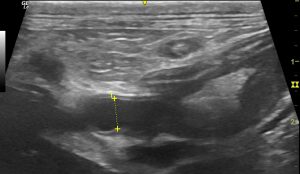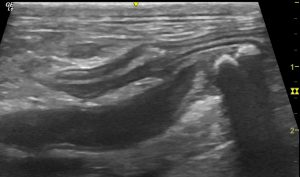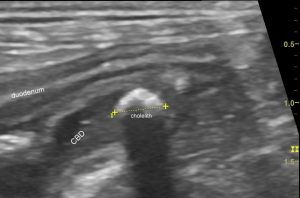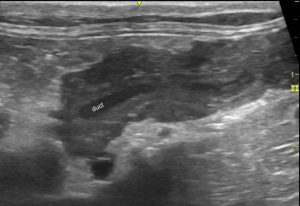Cholelithiasis as a potential cause of acute pancreatitis in a cat
Gall stones are a common cause of acute pancreatitis in people. In fact, potential cholelithiasis is purportedly the main reason to consider sonography in human patients with acute pancreatitis.
In cats and dogs this does not appear to be the case. In a recent review paper the always excellent Penny Watson states:
‘Gall stones are recognized in cats but are uncommon and their contribution to pancreatitis in this species is unknown’
J Small Anim Pract. 2015 Jan;56(1):3-12. doi: 10.1111/jsap.12293.
Pancreatitis in dogs and cats: definitions and pathophysiology.
Watson P.
https://www.ncbi.nlm.nih.gov/pubmed/25586802
I can’t claim to have searched exhaustively but there are a scatter of reported cases of concurrent pancreatitis and cholelithiasis in the published feline literature:
These authors include one case with concurrent pancreatitis and cholelithiasis: although no further details are given.
Pathogenesis and outcome of extrahepatic biliary obstruction in cats.
Mayhew PD, Holt DE, McLear RC, Washabau RJ.
J Small Anim Pract. 2002 Jun;43(6):247-53.
https://www.ncbi.nlm.nih.gov/pubmed/12074289
And:
Vet Radiol Ultrasound. 2007 Sep-Oct;48(5):439-47.
Ultrasonographic features of extrahepatic biliary obstruction in 30 cats.
Gaillot HA1, Penninck DG, Webster CR, Crawford S.
https://www.ncbi.nlm.nih.gov/pubmed/17899979
…adds another three in which pancreatic ‘thickening’ accompanied cholelithiasis.
So it seems worth posting this case: a 10 y.o FN DSH wth acute malaise, vomiting, icterus and collapse.
Her liver is diffusely hypoechoic consistent with an acute hepatopathy and there is echogenic gas in the intrahepatic biliary tracts.
The common bile duct is dilated:

Longitudinal plane view from the right side showing a dilated common bile duct
And further distal the reason for this is apparent:

Longitudinal plane view from the right side showing the common bile duct and two mineralised choleliths wedged proximal to the papilla.

The pancreas is apparently feeling the effects of this obstruction too:

Longitudinal plane view of the left pancreatic lobe: surrounding fat is markedly hyperechoic, contrasting with the swollen, hypoechoic pancreas.
Interestingly, this pancreas is subtly different from ‘routine’ acute pancreatitis in cats. The duct is bordered on a both sides by a discrete layer which I take to be probably the oedematous wall of the duct. In real time it was possible to see that the contents of the duct consisted of mobile secretion with very fine echogenic particulates. Given that there’s gas in the biliary tracts this might be an acute septic pancreatitis: a phenomenon well-documented in man but not in feline medicine.
Bratisl Lek Listy. 2006;107(8):296-313.
Septic complications of acute pancreatitis.
Mifkovic A1, Pindak D, Daniel I, Pechan J.
https://www.ncbi.nlm.nih.gov/pubmed/17125065
Sadly, given her parlous condition, poor prognosis and financial considerations euthanasia was performed.
Association is not necessarily causation obviously. I can’t rule out the possibility, for example, that pre-existing pancreatitis might have led to occlusion of the bile duct at the papilla and predisposed to obstructive cholelithiasis. Seems less likely though.





